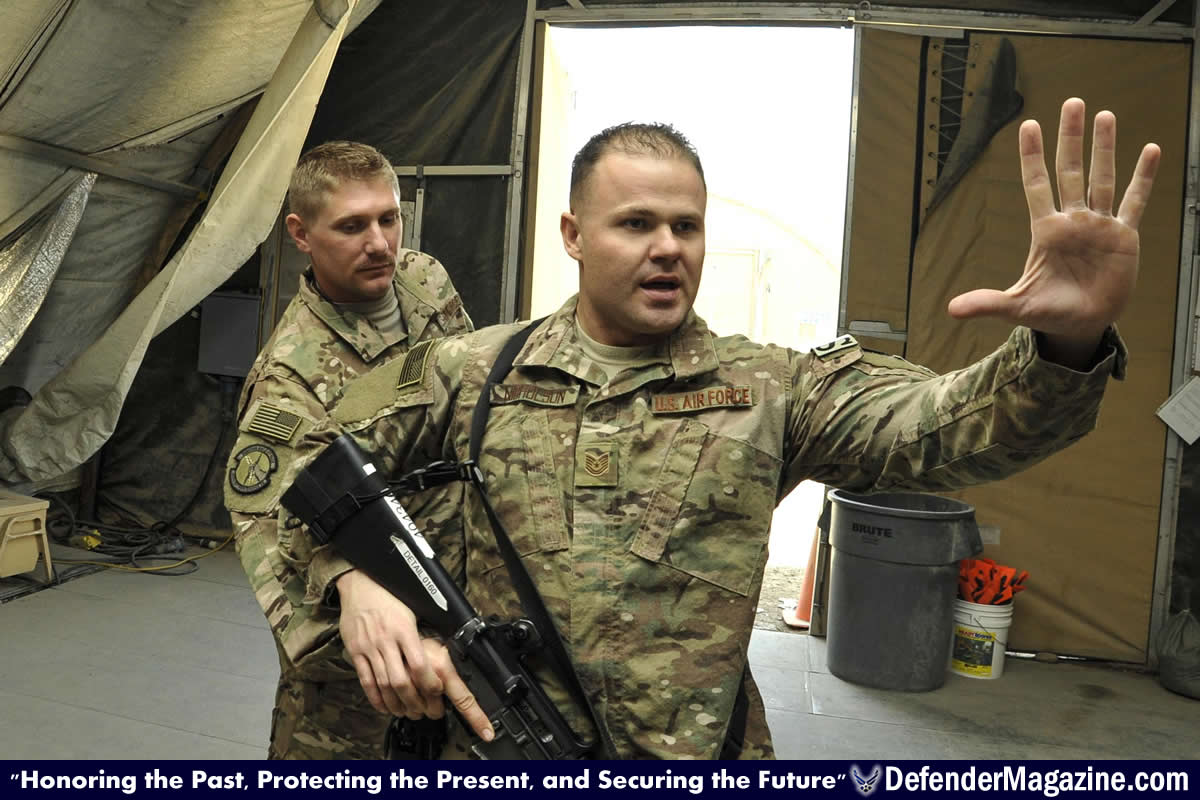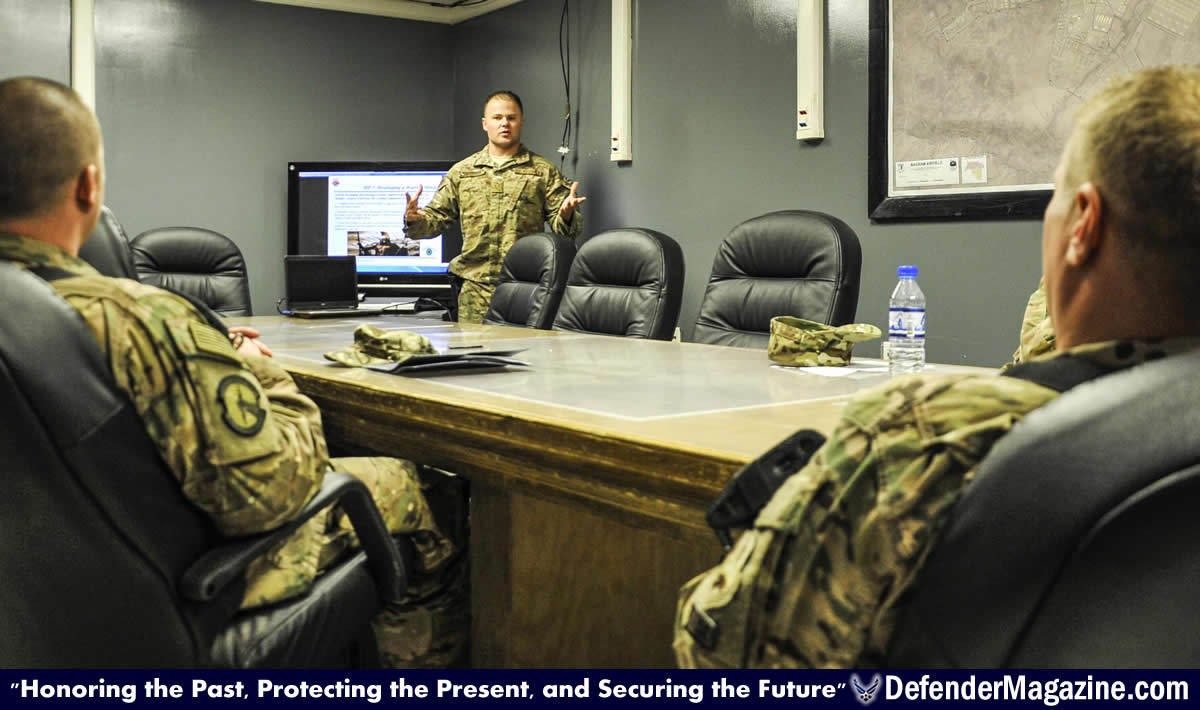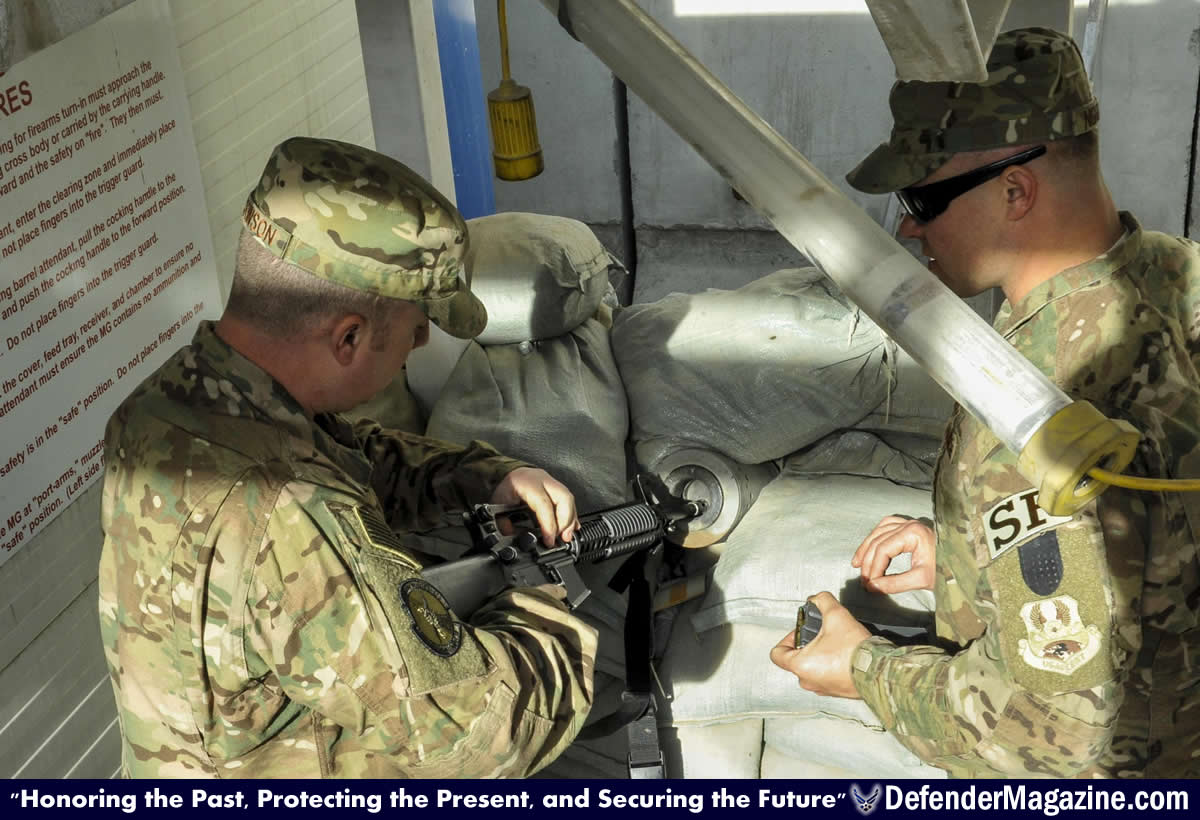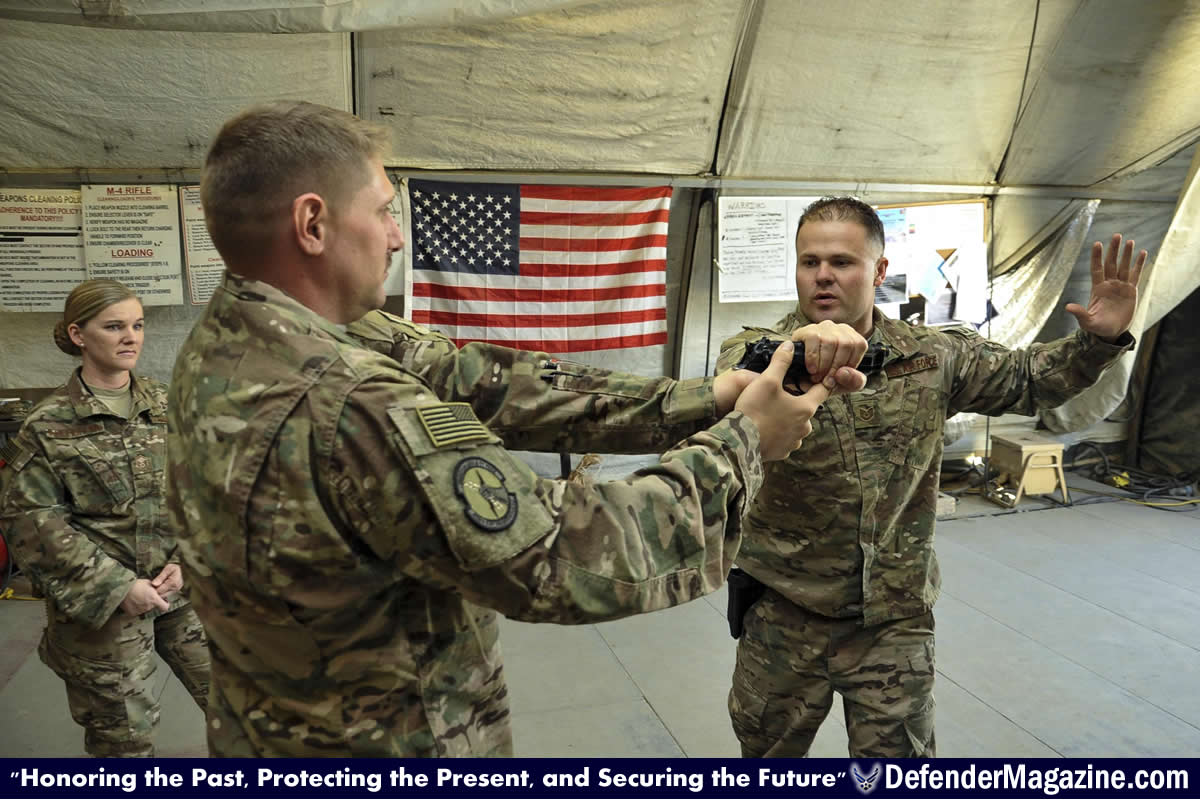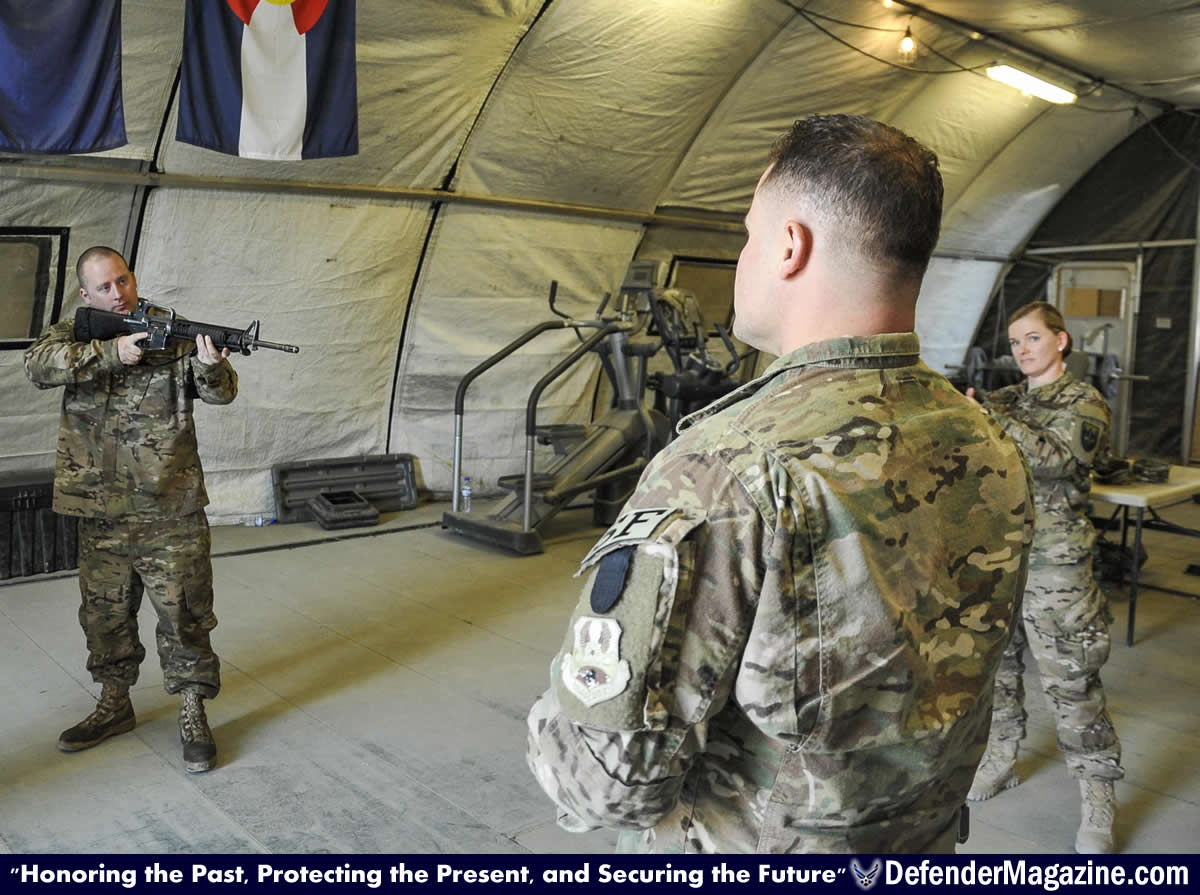12/17/2015 – BAGRAM AIRFIELD, Afghanistan —
Editor’s Note: This is the second article that is part of the Deployed Defenders series that takes a closer look at the function of Air Force Security Forces in Afghanistan.
With nearly 3,700 Airmen carrying weapons in Afghanistan, some of them for the first time since Basic Military Training, and with the threat of an active shooter in the region, the Check Six program trains service members for the worst-case scenarios.
“Due to increased active shooter and insider threats, leadership developed the Check Six program,” explained Tech. Sgt. Jason Nicholson, 455th Expeditionary Security Forces Squadron Check Six instructor for Afghanistan. “It’s designed to minimize casualties in the case of hostilities.”
Tech. Sgt. Jason Nicholson, 455th Expeditionary Security Forces Squadron Check Six instructor for Afghanistan, instructs a Check Six class on how to react if someone tries to take your weapon system at Bagram Airfield, Afghanistan Dec. 3, 2015. Since the training was implemented two years ago, no active shooter incident involving Airmen has taken place in the Afghanistan area of responsibility. (U.S. Air Force photo by Tech. Sgt. Nicholas Rau)
There have been tragic cases of documented insider threats and active shooters throughout the wartime efforts over the last 14 years, and with the increased rise in terrorist groups like ISIL and their sympathizers, Airmen in Afghanistan are required to be more aware and more proficient with their weapons.
“A majority of career fields don’t handle their weapon systems everyday like Security Forces, and aren’t as comfortable and confident with them,” said Nicholson. “So what we do is practice increased awareness with the weapon and ways to retain your weapon and disarm others. This prevents someone from taking your weapon and using it against you or your fellow Airmen.”
Since the training was implemented two years ago, no active shooter incident involving Airmen has taken place in the Afghanistan area of responsibility. While many factors contribute to this success, more and more Airmen say they are more aware and feel more comfortable with their weapons after the training.
“When I came here, I knew nothing about tactical weapon maneuvers, like retention and disarming,” said Staff Sgt. Chris Dickinson, 455th Expeditionary Maintenance Squadron, a recent course attendee. “Now I feel like I know better how to fight back and I am more aware of things. It was a great class.”
The course doesn’t only prepare you for an active shooter incident; it also instills confidence with the individual and their weapon system. This is something that Nicholson finds very important in deterring these types of events in Afghanistan.
“After looking at almost all of the active shooters, one thing is clear, they prey on the weak,” he said. “They’ll choose gun-free zones, because they are not looking for a fight. We always need to have the mindset that we will win in a fight, and carry ourselves that way; because active shooters don’t go into a fight that they think they’re going to lose.”
Check Six is also about preparing for future shifts in manning and missions, accounting for possible threats that may arise with changing dynamics.
“As we draw down our forces and become advisors in the area of responsibility, we are put in situations where we work closer with our mission partners,” explained Staff Sgt. KayLynn Perez, Air Force Central Command Check Six Program Manager. “This environment makes us more vulnerable to hostile risks. Therefore, the Check Six program becomes even more important since it gives all personnel the training and information needed to make a sound decision when confronted by these threats.”
While everyone in Afghanistan gets Check Six training when they arrive in country, the training doesn’t stop there. Nicholson goes to each unit to keep them up to date on their active shooter plan.
“It about being prepared versus not prepared,” he said, “and this training will save lives.”
By Tech Sgt. Nicholas Rau,
455th Air Expeditionary Wing Public Affairs
Published December 17, 2015
Tech. Sgt. Jason Nicholson, 455th Expeditionary Security Forces Squadron Check Six instructor for Afghanistan, teaches a class on how to be prepared in case of an active shooter threat at Bagram Airfield, Afghanistan Dec. 3, 2015. Since the training was implemented two years ago, no active shooter incident involving Airmen has taken place in the Afghanistan area of responsibility. (U.S. Air Force photo by Tech. Sgt. Nicholas Rau)
Tech. Sgt. Jason Nicholson, 455th Expeditionary Security Forces Squadron Check Six instructor for Afghanistan, directs Staff Sgt. Chris Dickinson, 455th Expeditionary Maintenance Squadron, to clear his weapon before the hands on portion of the Check Six class at Bagram Airfield, Afghanistan Dec. 3, 2015. Since the training was implemented two years ago, no active shooter incident involving Airmen has taken place in the Afghanistan area of responsibility. (U.S. Air Force photo by Tech. Sgt. Nicholas Rau)
Tech. Sgt. Jason Nicholson, 455th Expeditionary Security Forces Squadron Check Six instructor for Afghanistan, demonstrates to a Check Six class on how to react if someone points a handgun at you at Bagram Airfield, Afghanistan Dec. 3, 2015. Since the training was implemented two years ago, no active shooter incident involving Airmen has taken place in the Afghanistan area of responsibility. (U.S. Air Force photo by Tech. Sgt. Nicholas Rau)
Tech. Sgt. Jason Nicholson, 455th Expeditionary Security Forces Squadron Check Six instructor for Afghanistan, practices reaction drills with a Check Six class at Bagram Airfield, Afghanistan Dec. 3, 2015. Since the training was implemented two years ago, no active shooter incident involving Airmen has taken place in the Afghanistan area of responsibility. (U.S. Air Force photo by Tech. Sgt. Nicholas Rau)
